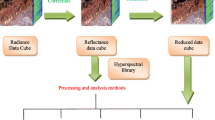Abstract
In order to support immediate decision-making in critical circumstances such as military reconnaissance and disaster rescue, real-time onboard implementation of target detection is greatly desired. In this paper, a real-time thresholding method (RT-THRES) is proposed to obtain the constant false alarm rate (CFAR) thresholds for target detection in real-time circumstances. RT-THRES utilizes Gaussian mixture model (GMM) to track and fit the distribution of the target detector’s outputs. GMM is an extension to Gaussian probability density function, which could approximate any distribution smoothly. In this method, GMM is utilized to model the detector’s output, and then the detection threshold is calculated to achieve a CFAR detection. The conventional GMM’s parameter estimation by Expectation-Maximization (EM) requires all data samples in the dataset to be involved during the procedure and the the parameters would be re-estimated when new data samples available. Thus, GMM is difficult to be applied in real-time processing when newly observed data samples coming progressively. To improve GMM’s application availability in time-critical circumstance, an optimization strategy is proposed by introducing the Incremental GMM (IGMM) which allows GMM’s parameter to be estimated online incrementally. Experiments on real hyperspectral image and synthetic dataset suggest that RT-THRES can track and model the detection outputs’ distribution accurately which ensures the accuracy of the calculation of CFAR thresholds. Moreover, by applying the optimization strategy the computational consumption of RT-THRES maintains relatively low.










Similar content being viewed by others
References
Basener B, Ientilucci E, Messinger D (2007) Improved hyperspectral anomaly detection in heavy-tailed backgrounds. Algorithms and Technologies for Multispectral, Hyperspectral, and Ultraspectral Imagery XIII, Proc. SPIE.
Bidon S, Besson O, Tourneret JY (2008) The adaptive coherence estimator is the generalized likelihood ratio test for a class of heterogeneous environments. IEEE Signal Processing Letters 15:281–284
Calinon S and Billard A (2007) Incremental learning of gestures by imitation in a humanoid robot. ACM/IEEE International Conference on Human-Robot Interaction.
Cameron AC, Windmeijer FAG (1997) An R-squared measure of goodness of fit for some common nonlinear regression models[J]. Journal of Econometrics Journal of Econometrics 77(2):329–334
Chang C-I. 2016 Real-time progressive hyperspectral image processing. Springer New York
Chapra SC, Canale RP (2014) Numerical methods for engineers 7ed. McGraw-Hill Education
Chen C, Zhang N (2012) An efficient method for incremental learning of GMM using CUDA. International Conference on Computer Science and Service System.
Dempster AP, Laird NM, Rubin DB (1977) Maximum likelihood from incomplete data via the EM algorithm. J R Stat Soc 39(1):1–38
Devore JL (2011) Probability and statistics for Engineering and the sciences, 8th edn. Cengage Learning, Boston, pp 508–510
Ensafi E and Stocker AD (2008) An adaptive CFAR algorithm for real-time hyperspectral target detection, Algorithms and Technologies for Multispectral, Hyperspectral, and Ultraspectral Imagery XIV, Proc. SPIE.
Frontera-Pons J and Pascal F (2013) False-alarm regulation for target detection in Hyperspectral Images. IEEE International Workshop on Computational Advances in Multi-Sensor Adaptive Processing.
Gupta MR, Chen Y (2011) Theory and use of the EM algorithm. Found Trends Sig Process 4(3):223–296
Kasen I, Goa PE, Skauli T (2004) Target detection in hyperspectral images based on multicomponent statistical models for representation of background clutter. Proceedings of the SPIE 5612:258–264
Kraut S, Scharf LL, Butler RW (2005) The adaptive coherence estimator: a uniformly most-powerful-invariant adaptive detection statistic. IEEE Trans Signal Process 53(2):427–438
Manolakis DG (2005) Taxonomy of detection algorithms for hyperspectral imaging applications. Signal Processing Magazine IEEE 44(6):29–43
Manolakis DG, Shaw G (2002) Detection algorithms for hyperspectral imaging applications. IEEE Signal Process Mag 19:29–43
Manolakis DG, Shaw GA, Keshava N (2000) Comparative analysis of hyperspectral adaptive matched filter detectors. Proc. SPIE 4049, Algorithms for Multispectral, Hyperspectral, and Ultraspectral Imagery VI., 2–17
Manolakis DG, Marden D, Kerekes JP, Shaw GA (2001) On the statistics of hyperspectral imaging data. Proc SPIE 4381(11):1953–1958
Piepera ML, Manolakisa D, Lockwood R (2011) Hyperspectral detection and discrimination using the ACE Algorithm. Imaging Spectrometry XVI, 815807.
Pinto RC, Engel PM et al (2015) PLoS One 10(10):e0141942
Plaza AJ, Chang C-I 2007 High performance computing in remote sensing. Chapman and Hall/CRC
Qian D (2007) Unsupervised real-time constrained linear discriminant analysis to hyperspectral image classification. Pattern Recogn 40:1510–1519
Qian D, Nekovei R (2009) Fast real-time onboard processing of hyperspectral imagery for detection and classification[J]. J Real-Time Image Proc 4(3):273–286
Reed I, Yo X (1990) Adaptive multiple-band CFAR detection of an optical pattern with unknown spectral distribution. IEEE Trans Acoust Speech Signal Proc 38:1760–1770
Snyder D, Kerekes J, Fairweather I, Crabtree R, Shive J, Hager S (2008) Development of a web-based application to evaluate target finding algorithms. Proceedings of the 2008 I.E. International Geoscience and Remote Sensing Symposium (IGARSS) 2:915–918
Tarabalka Y, Haavardsholm TV, Kåsen I, Skauli T (2009) Real-time anomaly detection in hyperspectral images using multivariate normal mixture models and GPU processing. J Real-Time Image Proc 4(3):287–300
Zhang Z (2011) An improvement to the Brent’s method. Int J Exp Algorithm 2(1):21–26
Zhang Y, Chen L, Ran X (2010) Online incremental EM training of GMM and its application to speech processing applications. 2010 I.E. 10th International Conference on Signal Processing (ICSP).
Author information
Authors and Affiliations
Corresponding author
Rights and permissions
About this article
Cite this article
Zhao, H., Lou, C. & Li, N. A real-time CFAR thresholding method for target detection in hyperspectral images. Multimed Tools Appl 76, 15155–15171 (2017). https://doi.org/10.1007/s11042-017-4693-y
Received:
Revised:
Accepted:
Published:
Issue Date:
DOI: https://doi.org/10.1007/s11042-017-4693-y




